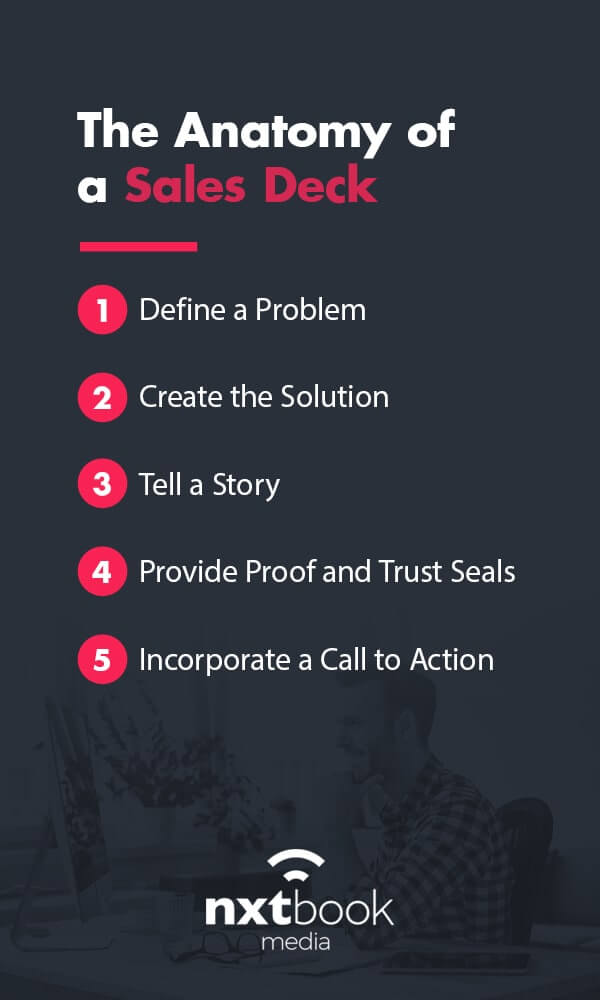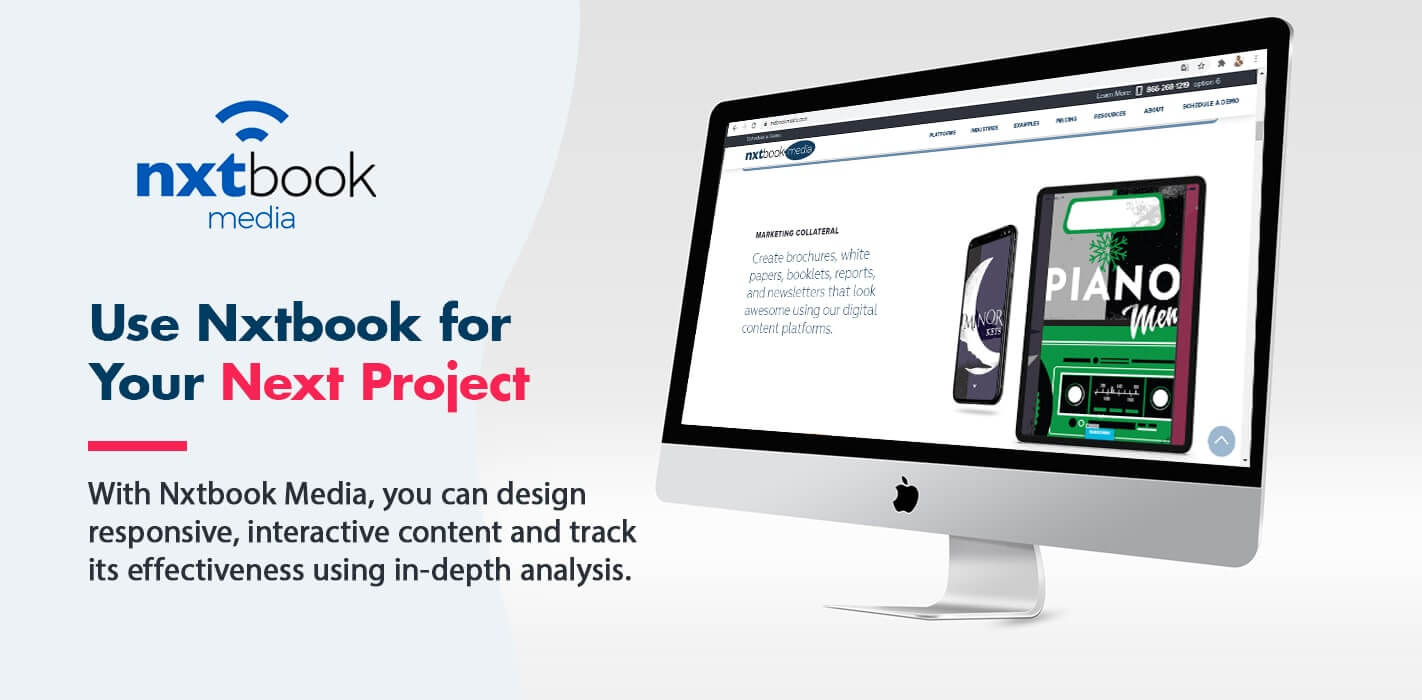Creating a Sales Deck That Makes Your Brand Stand Out

Written by Matt Berringer
April 20, 2021
What is a sales deck? A sales deck is the presentation a company shows potential clients to win them over. Your sales deck is your chance to convey your central messages — who you are as a company, what you do and why potential clients or partners should choose you. It presents an opportunity to stand out from the noise and explain why your brand is the best choice.
Effective sales decks earn conversions. Creating the most compelling possible sales deck can make the difference between winning business or losing it. It’s a high-stakes endeavor, which is why it’s so essential to get it right. A successful sales deck design is all about narrative, visuals, engagement and trust-building. Read on to learn the best practices for creating a sales presentation that helps you achieve your goals.
How Does Your Sales Deck Map to Your Sales Process?
Your sales deck should fit within the steps you take at every stage of a buyer’s journey, with the ultimate goal of conversion. Your sales process should be consistent from one customer to the next. If you have yet to do so, create a flowchart explaining what to do at each consumer decision point. The early stages include education, providing helpful resources for your consumers and defining your brand as knowledgeable.
Conceptualize where your sales deck fits into your sales process. At what point during the buyer’s journey should they see your sales deck? What is the buyer’s next step after viewing your sales deck? At what point between awareness and conversion does your sales deck sit? Answer this question first — this will help guide you as you plan your sales deck. Before you get started creating your sales deck, determine what you want it to achieve.
How to Create a Sales Deck
Once you’ve decided where the sales deck fits into your overall sales process, you can begin designing it. Your sales deck should explain everything you want potential clients to know about your brand. You won’t have the chance to engage in a conversation with every potential buyer — your sales deck should speak for you, saying everything you would about your business and brand. Though a sales deck should supplement a pitch or demo, it should also stand on its own.
Effectively conveying your central messages in your sales deck can make the difference between a conversion or a loss of a potential client. Your sales deck has to provide a definitive answer as to why buyers should choose your brand. Perform market research and have a thorough understanding of your audience. Learn about the components of a sales pitch deck and how you can make yours compelling and successful.
The Anatomy of a Sales Deck
When you start creating your sales presentation, follow a clear, predetermined structure. Determine your outline. Remember, your goals should be to get the potential client’s attention, tell your story and convince them to choose you. Keep it simple. Your pitch deck outline should achieve all the following objectives.
Define a Problem
First, define the problem your company solves. Explain how this issue impacts the potential client and why they should care about solving it. Doing so is especially crucial if you serve a niche role that not everyone will understand right off the bat. You might use this as a chance to spark an emotional response. If available, provide real-world examples relevant to the problem. Incorporate statistics, data and testimonials.
For instance, if your company provides technology for consumer data acquisition, the first thing you’ll want to explain is how companies lose business by not understanding their consumer audiences. Include case studies of this dilemma in action, with compelling facts and figures.
Create the Solution
Once you’ve established the problem, explain how your brand is the solution. Describe how your product or service is novel, different and the best possible choice. Use clear, easy-to-understand language. Offer an overview of what you deliver, who you serve and the results clients can expect. This summary should be concise, compelling and unmistakable. You might also present other possible solutions, explaining how they’re not as effective as yours.
Let’s say, for example, you sell mass-produced agenda books for educational purposes. Explain the problem — college students often struggle to remember all their assignments, which leads to poor grades, failing test scores and fewer placements in prestigious grad schools. Anyone who might be purchasing bulk orders of educational materials will see this as a concern, even if they had not considered it before.
Having presented the problem at hand, you’ll need to explain how you provide a solution. With your company’s user-friendly, practical agenda books, students will remember their assignments and achieve their academic goals. You might provide data from schools that provide these planners to their students. Pose your company as the best possible solution to the concern you’ve laid out.
Tell a Story
For better connection and memorability, tell a story. People remember stories. Storytelling is the most effective method for conveying information while promoting retention. Stories are also engaging — they keep the reader or listener interested. If you want prospective clients to remember your brand, use sales pitch storytelling.
How you incorporate storytelling could take on many forms. Make sure it’s relevant to the consumer’s interests and needs — in other words, do not prattle on about how your company came to be or how you’ve grown. Instead, you might talk about a successful case study, presented as a narrative. Detail how you’ve helped a previous client achieve their goals. Or, tell the story in more general terms, explaining how a nameless consumer would benefit from your services. Use storytelling to explain how you take clients from point “A” to point “B.”
Provide Proof and Trust Seals
Consumers are too savvy to fall for vague promises. Within your sales deck, make it clear why you’re trustworthy. Provide accurate data, numbers and examples. Prove your superiority to your competitors, and leave no room for doubt. Give them a reason to trust you. Be careful not to bore your client during this stage. Instead, you might incorporate “proof” statistics into your storytelling.
Incorporate a Call to Action
A sales deck must conclude with a concise call to action. You want the potential client to know what steps they should take next. Here is where mapping out your sales process will come in handy.
Have a specific idea of what you want your consumer to do next after completing your sales deck. Do you want them to sign up for a trial? Fill out a contact form? Or should this be the final step before conversion? Decide what you want the potential client to do, and compel them to do so.
Identify Your Resources
Before you start creating your sales deck, gather your resources. Based on the resources you have, decide how you can make the most compelling sales pitch. You might consider broadening your arsenal of resources, using the latest technology and software.
Competitive Position
Consider where you stand compared to the competition. Are you an industry leader? Are you a new start-up? You might choose to use your competitive position as a selling point, helping you build trust with new prospective clients.
Testimonials and Reviews
Testimonials and reviews are a powerful tool. Potential clients might have a healthy dose of skepticism regarding the claims you make about yourself. Since your goal is to win their business, they might expect you to exaggerate your capabilities. Testimonials and reviews come from your previous customers, which will help you build credibility. If previous clients have left you positive reviews, consider including some in your presentation.
Design Capabilities
You’ll also have to remember your design capabilities and limitations. Consider the different tools you might use to create your sales deck. Think about how design tools and platforms will help you convey your messages. If you only have access to a bare-bones slide presentation tool and a few amateur photos, you might struggle to keep your audience’s attention. Instead, seek high-quality design resources.
Create something unique using the best possible digital publishing toolkit. To develop a compelling sales deck, you’ll need photo, video and graphic design resources. Find the best design resources before you start putting the pieces together. You’ll end up with a more professional finished product.
Use an Engaging Design
Once you’ve put together an outline and storyboard for your sales deck, you can begin designing it. Design elements can make or break your final product. Even the best sales deck ideas require an engaging design to be effective. When creating your sales deck, imagine you’re seeing it for the first time. What would grab your attention? What would compel you to continue to the next slide? Use colors, figures, visuals and interactive elements to keep your audience interested.
Show, Don’t Tell
If you spout claims about how your company is the best but provide little evidence, few people will believe you, even if it’s true. Cite numbers, statistics and case studies, using graphs and other visual cues. Demonstrate your success, rather than making unsupported claims.
Create Interactive Digital Content
When you create your sales deck, make it as engaging as possible. A simple click-through presentation might not be enough to hold your audience’s attention. Instead, you might consider creating interactive digital content, which will make the audience member an active participant. Doing this is an excellent way to promote engagement and retain viewers through your call to action.
Tell a Visual Story
If your pitch deck is too content-heavy, your audience will lose interest. Make efficient use of visuals for a successful finished product. Use colorful graphs and figures, cartoon characters or other visual cues to keep the audience engaged. Keep in mind that stories move from left to right, as should your visuals.
Find the Right Design Tools
Find the tools that work best to serve your goals. If you create a sales deck that’s exciting and innovative, you’ll be more likely to keep your viewers’ attention and earn more conversions. Make sure the design tools you select are user-friendly.
Promote Your Sales Deck
Once you’ve created your sales deck, you’ll have to promote it. All the planning, thought and effort you put into your sales deck can only result in conversions if prospective clients see the finished product. Use available means to get your sales pitch in the right hands.
Use All Available Channels
Promote your sales deck at every possible opportunity. You might send it to potential clients via email, incorporate it into your social media presence or partner with other companies who will host or share it for you. Find a place for it on your website where visitors will be able to access it. Use all the available channels through which you might reach potential clients.
Work With Your Sales Team
Work with your sales team to promote your sales deck. Ensure every member of your sales team has access to the sales deck and understands it forward and backward. Ask your team members to practice running through the sales deck as if they were presenting it to a potential client. Incentivize earning conversions using the sales deck.
Be sure to track who sees your sales deck. You might incorporate a lead magnet, requesting viewer emails in exchange for the content. After enough potential clients have seen your sales deck, you can begin measuring its effectiveness. If your sales deck is not resulting in conversions, you might need to make changes and updates. If you have access to detailed data, you’ll know what specific changes to make.
Track, Analyze and Improve
It’s vital to track your sales deck’s success. You can track how many potential clients download your sales deck, how much time they spend on each page, how much they engage with the interactive elements, whether they finish the presentation and other pivotal data points. This information will help you make future improvements.
Once you know when and how potential clients engage with your sales deck, you can determine how to best improve it. For instance, if those who download your sales deck tend to close out of the document when they reach page four, you’ll know that section needs an upgrade. This data will help you create the best possible sales deck and earn more conversions.
Use Nxtbook for Your Next Project
An effective sales deck serves many purposes. It helps you tell your story, set yourself apart, show off your capabilities, establish your brand and earn more conversions. To create the best possible sales deck, using an engaging design is vital. If you want to stand out, consider using Nxtbook Media digital content platforms.
With Nxtbook Media, you can design responsive, interactive content and track its effectiveness using in-depth analysis. You can also match the look and feel of your existing print or PDF design. We offer the most customizable and interactive replica platform on the market. Create an attention-grabbing, engaging sales deck with our digital media services and earn more conversions. For a free demo, contact us today.



